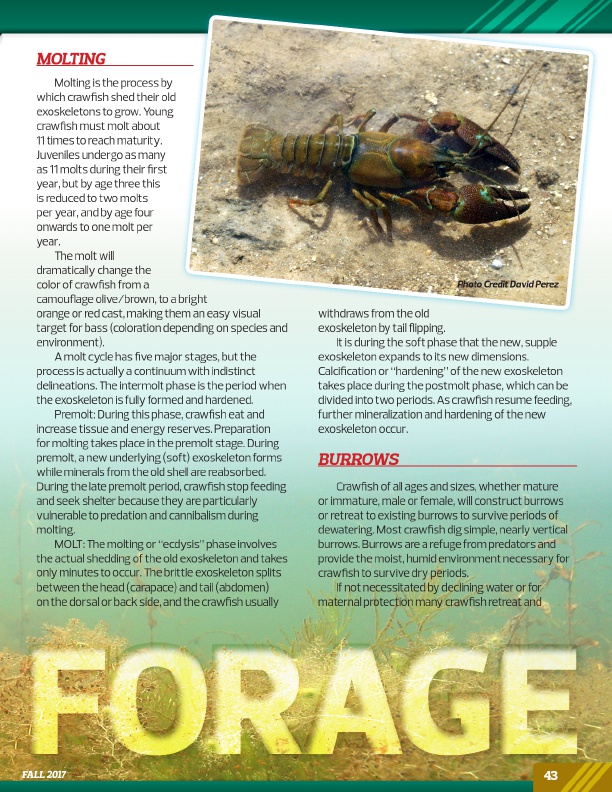
FORA G E
MOLTING
Molting is the process by which crawfish shed their old exoskeletons to grow. Young crawfish must molt about 11 times to reach maturity. Juveniles undergo as many as 11 molts during their first year, but by age three this
is reduced to two molts
per year, and by age four
onwards to one molt per
year.
The molt will
dramatically change the
color of crawfish from a
Photo Credit David Perez
camouflage olive/brown, to a bright
orange or red cast, making them an easy visual
withdraws from the old
target for bass (coloration depending on species and
exoskeleton by tail flipping.
environment).
It is during the soft phase that the new, supple
A molt cycle has five major stages, but the
exoskeleton expands to its new dimensions.
process is actually a continuum with indistinct
Calcification or “hardening” of the new exoskeleton
delineations. The intermolt phase is the period when
takes place during the postmolt phase, which can be
the exoskeleton is fully formed and hardened.
divided into two periods. As crawfish resume feeding,
Premolt: During this phase, crawfish eat and
further mineralization and hardening of the new
increase tissue and energy reserves. Preparation
exoskeleton occur.
for molting takes place in the premolt stage. During
premolt, a new underlying (soft) exoskeleton forms while minerals from the old shell are reabsorbed.
BURROWS
During the late premolt period, crawfish stop feeding
Crawfish of all ages and sizes, whether mature
and seek shelter because they are particularly
or immature, male or female, will construct burrows
vulnerable to predation and cannibalism during
or retreat to existing burrows to survive periods of
molting.
dewatering. Most crawfish dig simple, nearly vertical
MOLT: The molting or “ecdysis” phase involves
burrows. Burrows are a refuge from predators and
the actual shedding of the old exoskeleton and takes
provide the moist, humid environment necessary for
only minutes to occur. The brittle exoskeleton splits
crawfish to survive dry periods.
between the head (carapace) and tail (abdomen)
If not necessitated by declining water or for
on the dorsal or back side, and the crawfish usually
maternal protection many crawfish retreat and
FALL 2017
43